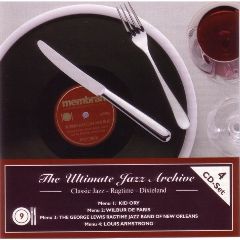The Ultimate Jazz Archive Vol.33 - Kid Ory [1948] [2005]
The Ultimate Jazz Archive Vol.33 - Kid Ory [1948] [2005]

01.Panama Rag 02.Sister Kate 03.Mahogany Hall Stomp 04.Margie 05.Chinatown, My Chinatown 06.Do You Know What It Means, To Miss New Orleans 07.Sugar Foot Stomp 08.Black And Blue 09.Oh! Didn’t He Ramble 10.At The Jazz Band Ball 11.High Society 12.Sweet Georgia Brown 13.San 14.Shake That Thing 15.Ory’s Boogie
Kid Ory was one of the great New Orleans pioneers, an early trombonist who virtually defined the "tailgate" style (using his horn to play rhythmic bass lines in the front line behind the trumpet and clarinet) and who was fortunate enough to last through the lean years so he could make a major comeback in the mid-'40s. Originally a banjoist, Ory soon switched to trombone and by 1911 was leading a popular band in New Orleans. Among his trumpeters during the next eight years were Mutt Carey, King Oliver and a young Louis Armstrong and his clarinetists included Johnny Dodds, Sidney Bechet, and Jimmie Noone. In 1919, Ory moved to California and in 1922 (possibly 1921) recorded the first two titles by a Black New Orleans jazz band ("Ory's Creole Trombone" and "Society Blues") under the band title of Spike's Seven Pods of Pepper Orchestra. In 1925 he moved to Chicago, played regularly with King Oliver, and recorded many classic sides with Oliver, Louis Armstrong (in his Hot Five and Seven), and Jelly Roll Morton, among others.
The definitive New Orleans trombonist of the 1920s, Ory (whose "Muskrat Ramble" became a standard) was mostly out of music after 1930, running a chicken ranch with his brother. However in 1942 he was persuaded to return, and after a stint with Barney Bigard's group, he formed his own band. Ory's group was featured on Orson Welles' radio show in 1944 and the publicity made it possible for the band to catch on. The New Orleans revival was in full swing and Ory (whose group included trumpeter Mutt Carey and clarinetists Omer Simeon or Darnell Howard) was still in prime form. He appeared in the 1946 film New Orleans (and later on in The Benny Goodman Story) and worked steadily in Los Angeles. After Mutt Carey departed in 1948, Ory used Teddy Buckner, Marty Marsala, Alvin Alcorn (the perfect musician for his group), and Red Allen on trumpets and his Dixieland bands always boasted high musicianship (even with the leader's purposely primitive style) and a consistent level of excitement. They recorded regularly (most notably for Good Time Jazz) up to 1960 by which time Ory (already 73) was cutting back on his activities. He retired altogether in 1966, moving to Hawaii. ---Scott Yanow, Rovi
download:
uploaded yandex 4shared mediafire mega solidfiles zalivalka cloudmailru filecloudio anonfiles oboom
Last Updated (Friday, 12 September 2014 12:24)








